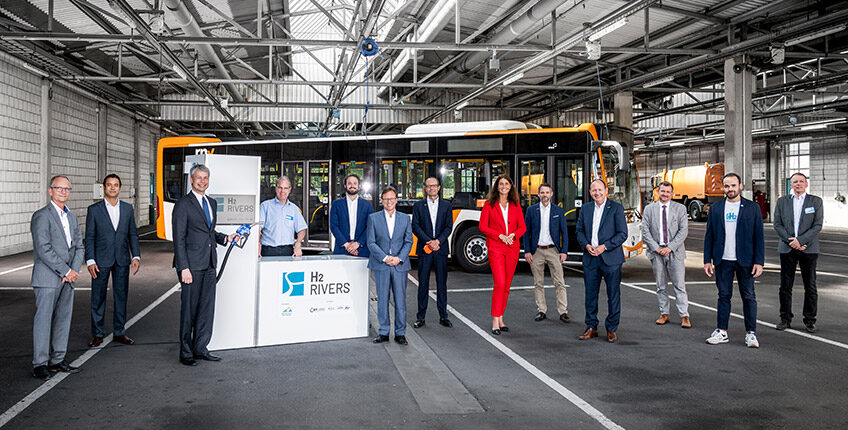Seven mobility sub-projects belonging to the HyPerformer “H2Rivers” project of the Rhine-Neckar metropolitan region are now ready to embark on the practical implementation of their planned measures.
The Parliamentary State Secretary at the Federal Ministry of Transport and Digital Infrastructure (BMVI – Bundesministerium für Verkehr und Digitale Infrastruktur), Steffen Bilger, handed over the funding notifications at an event taking place at the Rhine-Neckar Transport (rnv – Rhein-Neckar-Verkehr) depot in Ludwigshafen-Rheingönheim and stated: “With the ‘HyLand – Hydrogen Regions in Germany’ scheme, the BMVI is promoting integrated regional hydrogen concepts. The Rhine-Neckar metropolitan region is already engaged in practical implementation as a HyPerformer region. The H2Rivers project shows how hydrogen and fuel cell technology can be brought to market. Here, sustainability and cost-effectiveness go hand in hand.”
The development of the Hydrogen Region in the Rhine-Neckar metropolitan and central Neckar region is being supported with a total of 20 million euros in funding by the Federal Ministry of Transport and Digital Infrastructure as part of the National Innovation Programme Hydrogen and Fuel Cell Technology (NIP2). The “H2Rivers” consortium, led by Metropolregion Rhein-Neckar GmbH, was one of three applicants to be selected as a HyPerformer in the highest funding category of the HyLand competition at the end of 2019. The funding guideline is coordinated by NOW GmbH and implemented by Project Management Jülich (PtJ).
The first seven funding decisions with a combined total volume of 16,538,392.50 euros will go to the following projects in Heidelberg, Ludwigshafen, Mannheim and Esslingen:
Airliquide „H2ub“
With a capacity of 3 tonnes of H2 per day, the central high-pressure hydrogen filling centre “H2ub” is being built on Friesenheim Island in Mannheim. It will serve as the heart and backbone of all mobility applications of the overall H2Rivers project. As a consortium partner, Air Liquide will be constructing the compression plant.
The H2ub combines the hydrogen requirements of many individual projects and thus enables security of supply to be achieved cost-effectively. The green hydrogen will be produced in large-scale production facilities at the neighbouring BASF plant in Ludwigshafen. In the H2ub, the hydrogen is purified for use in fuel cells and compressed for filling into storage tankers.
The H2ub will supply both existing and future H2 mobility applications in the region with hydrogen. For the necessary transport of the hydrogen from the central filling centre to the various filling stations, a total of 12 hydrogen tanker trucks will also be procured, which can also be used as additional mobile storage tanks.
The project is being supported by the BMVI with funds totalling 5,024,000 euros.
H2 MOBILITY hydrogen filling stations
H2 MOBILITY is a joint venture of companies from the petroleum and gas industry, vehicle manufacturers and other associated partners. It is responsible for the comprehensive development of a hydrogen infrastructure in Germany and is establishing two high-performance public hydrogen filling stations in Ludwigshafen and the surrounding area as part of the project. The filling stations each have pumps for 350 bar (buses, trucks) and 700 bar (cars, light commercial vehicles), and can consequently be used for the entire spectrum of existing and future fuel cell vehicles. The BMVI is providing funding of 5,136,000.00 euros for the project.
Nikolas Iwan, Managing Director of H2 MOBILITY Deutschland GmbH & Co.KG: “Hydrogen mobility will make a major contribution to reducing emissions in road traffic. For this to succeed, the infrastructure first needs to be put in place, because only where there is a reliable H2 filling station network will the transition be successful – in individual mobility, in public transport and in logistics. Projects such as H2Rivers are essential because they allow the hydrogen infrastructure to be built in sync with the ramp-up of vehicles.”
Waste collection vehicles
The cities of Heidelberg, Ludwigshafen and Mannheim will each receive a hydrogen waste collection vehicle for their municipal waste disposal operations as part of the H2 Rivers project and their jointly developed Sustainable Mobility Master Plan (Green City Plan) in 2018. The aim is to gain experience in practical applications through the use of the three vehicles, to sustainably minimise transport emissions and to successively convert the municipal vehicle fleets to zero-emission drive concepts in other vehicle areas, too.
The procurements are funded within the framework of the NIP 2 Sustainable Mobility priority area via the call for “Funding of waste collection vehicles and sweepers with fuel cell drives” (“Förderung von Abfallsammelfahrzeugen und Kehrfahrzeugen mit Brennstoffzellenantrieb”), amounting to 756,932 euros for Heidelberg, 605,231 euros for Ludwigshafen and 744,000 euros for Mannheim.
“Fuel cell mobility, the conversion of chemical energy into electrical energy, is an important building block for the diversification of drive systems. Fuel cell mobility is the mobility of the future. And as a city administration, we are extremely proud to be able to contribute our share to the nationwide development of a hydrogen infrastructure,” says Alexander Thewalt, Head of the Department of Construction, Environment and Transport, WBL of the Ludwigshafen City Administration.
Peter Nebel, Works Director of Wirtschaftsbetrieb Ludwigshafen (WBL), adds: “The use of hydrogen-powered municipal vehicles is a great opportunity for us to demonstrate the suitability of this technology for everyday use as well as making our own contribution to reducing emissions for the people of Ludwigshafen. We are very pleased to be able to actively participate as a consortium partner in the ‘H2-Rivers’ project, which is unique in Germany.”
Christian Specht, First Mayor of the City of Mannheim and Chairman of the rnv Supervisory Board: “We are delighted and grateful for the generous funding commitment from the federal government and the excellent cooperation in the metropolitan region with the H2Rivers project partners. As is widely known, the automobile was invented in Mannheim – which is another reason why we, as the city of Mannheim, aspire to be pioneers in the use of innovative environmental technologies. Indeed, already today, we are eager to gain experience with this new drive technology and to increasingly implement it in our municipal fleet of more than 800 vehicles. In doing so, we will continue to exchange ideas with our project partners, especially from Ludwigshafen and Heidelberg, on topics such as driving practice, workshop services and filling station infrastructure.”
Heidelberg’s Mayor for Climate Protection, Environment and Mobility, Raoul Schmidt-Lamontain, emphasised the benefits for his city: “The fuel cell drive also offers the potential to convert the vehicle fleet to zero-emission drives in the area of heavy-duty vehicles. It therefore represents another important milestone in the decarbonisation of the municipal vehicle fleet.”
Leasing vehicles from Kazenmaier Fleetservice GmbH
Kazenmaier Fleetservice GmbH will receive funding of 3,883,729 euros for the procurement of 90 vehicles as well as a filling station unit for its fuel cell-powered forklifts.
Within the H2Rivers project, Kazenmaier is the key mobility partner for BASF SE at the Ludwigshafen site as well as leasing partner for the introduction of the H2 buses in the Rems-Murr district. Additional H2 vehicles as well as H2 commercial vehicles will be made available in the project area for other interested parties.
“With the H2River project, we are continuing to work on the technology-open future of mobility. We are focusing on hydrogen in applications that make good sense from a technical, economic and ecological perspective,” says Max Nastold, Managing Director of Kazenmaier Fleetservice GmbH.
Pilot series vehicles in the Esslingen district
The Esslingen district’s “Zero emission road maintenance service (LKES²)” sub-project is receiving 388,500 euros in funding towards the procurement of two fuel cell road maintenance service vehicles.
The vehicles with a maximum permissible weight of 4.6 tonnes will be built as pilot series vehicles. The Esslingen district is cooperating with the Esslingen University of Applied Sciences, the company Elektrofahrzeuge Stuttgart (EFA-S) and other partners from the regional economy for this project. In the view of experts from science and in practice, the benefits of this vehicle concept lie in its very good market prospects. Not only can these vehicles be used in road maintenance depots, they also cover the classic range of uses of a vehicle in municipal building yards. Another major advantage of this vehicle concept is that the existing hydrogen filling stations, which have the more widespread 700 bar system, can be used.
“For me, it has always been important not to get bogged down in concepts, but rather to take action. Our project is a prime example of the innovative strength of the companies, institutions and universities in our district. With projects such as this, we can provide the impulses for successfully shaping structural change,” says Esslingen District Administrator Heinz Eininger.
The Managing Directors of Rhein-Neckar-Verkehr GmbH (rnv), which hosted the event, expressed their commitment of being future users of hydrogen mobility.
Christian Volz: “As a local transport company and also as today’s host, we are delighted about the funding decisions that were handed over to our consortium partners. We are also committed to contributing to the development of a hydrogen economy in the Rhine-Neckar metropolitan region and have therefore applied for support for the procurement of eight articulated hydrogen buses. On the one hand, this will enable us to ensure the required demand for hydrogen and, at the same time, accelerate the electrification of our bus fleet. Our credo here is of course not ‘whatever the cost’, but rather “’we are investing in the future’ – for our customers and passengers. After all, if public transport is to remain one of the most important contributors towards the achievement of our common climate protection goals, then we will need to be creative and not only look for solutions, but also genuinely wish to find them. This is where completely new possibilities are now opening up, where we see true opportunities, where we see a real and affordable basis for stable drive systems as well as continued reliable and environmentally friendly public transport.”
Martin in der Beek adds: “From experiments and trials, reality and self-evidence can emerge. And it precisely for this reason that we in our sector, local public transport, must be open to any innovation and any alternative to the currently available drive systems if we are to remain in pole position and continue to move forward in the future. For this reason, we not only find this venture exciting and interesting, but are even pinning our hopes on the field of H2. While public transport is already environmentally friendly per se, that doesn’t mean we should rest on our laurels.”
Image source: MRN/Schwerdt


